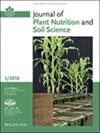Sorption of Sulfonamide Antibiotics in Peat Soils With Different Properties
Abstract
Background
Sulfonamide antibiotics have been discovered as emerging pharmaceutical pollutants worldwide and are only poorly removed in wastewater treatment. At the landscape level, peat soils are significant water collectors and, thus, are sinks for organic pollutants. However, the fate of pharmaceutically active contaminants in peat soil is, as yet, largely unclear.
Aim
Factors regulating sorption as a dominant process that influences the filtering and buffering of the sulfonamides sulfadiazine (SDZ) and sulfamethoxazole (SMX) in different peat soils were investigated.
Methods
The sorption of SDZ and SMX was investigated in batch sorption experiments using peat soils with different physicochemical properties and under different land use, including sustainable wet peatland cultivation (paludiculture).
Results
Sorption Kd values ranged from 21.39 to 102.8 mL g−1 for SDZ and 11.23 to 107.3 mL g−1 for SMX. Soil pH, organic carbon content, and C/N ratios were significantly correlated to sorption of the sulfonamides. Non-linear regression analyses showed that the Freundlich isotherm model was generally best suited to describe sorption of both sulfonamides (0.54 ≤ R ≤ 0.98). Freundlich n values were generally different from 1 for both sulfonamides, indicating co-mechanistic sorption as opposed to partitioning alone. A quantitative structure–property relationship (QSPR) constructed to predict sorption Kd values showed a good cross-validated performance (R2adj = 0.79, root mean squared error [RMSE] = 8.71).
Conclusions
The sorptive capacities of peat soils for SDZ and SMX antibiotics are higher than those of many terrestrial soils. The quantity and stoichiometric properties of the organic matter fraction, as well as the pH conditions, significantly affect the ability of the soils to immobilize these antibiotics.


 求助内容:
求助内容: 应助结果提醒方式:
应助结果提醒方式:


